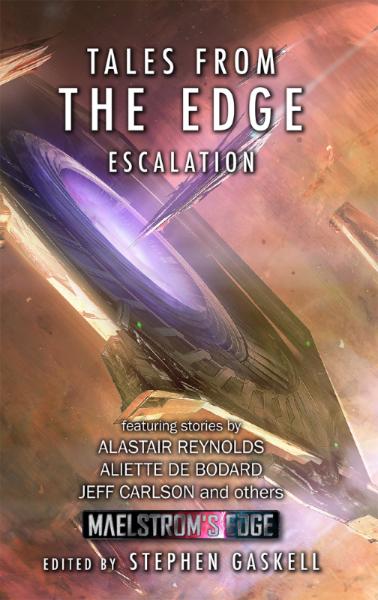Droning on in support - New Epirian Digital Model!
Posted on Monday Sept 04, 2023 at 08:55pm in Models
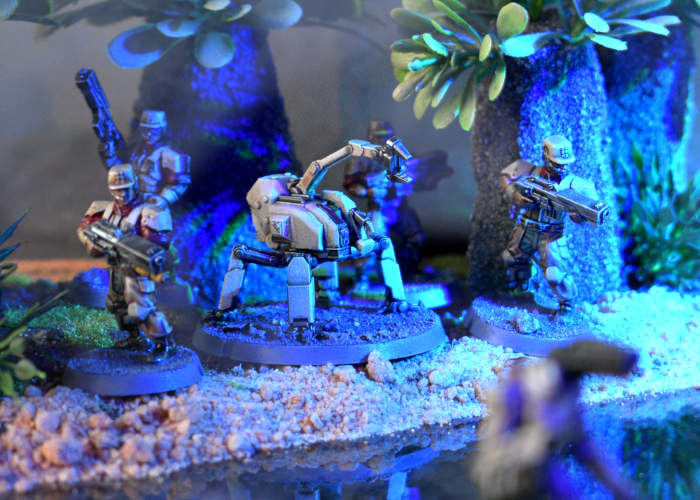
A Contractor Engineer unit advances cautiously along a waterline.
This kit is comprised of a Support Drone chassis, and optional parts to equip it to join any of three different Contractor unit types. The Recon Package is the standard gear for support drones utilised by Contractor Scout units. Contractor Engineers make use of tool-equipped drones to effect repairs on other damaged bots, while medical drones in Contractor Medic units patch up the force's less hardy human elements. The digital model pack contains STL files for both supported and unsupported versions of the Support Drone, with multiple equipment options. The model has been slightly updated from the original resin release, featuring taller legs to boost the overall size of the drone.
Support Drone Render
You can find the rules for all of these Epirian unit in the downloads section of the Maelstrom's Edge website here.
Start building your army of shooty robotic doom by grabbing your Support Drone from the webstore here!
New Epirian STL release - Contractor Drone!
Posted on Monday Aug 07, 2023 at 05:00pm in Models
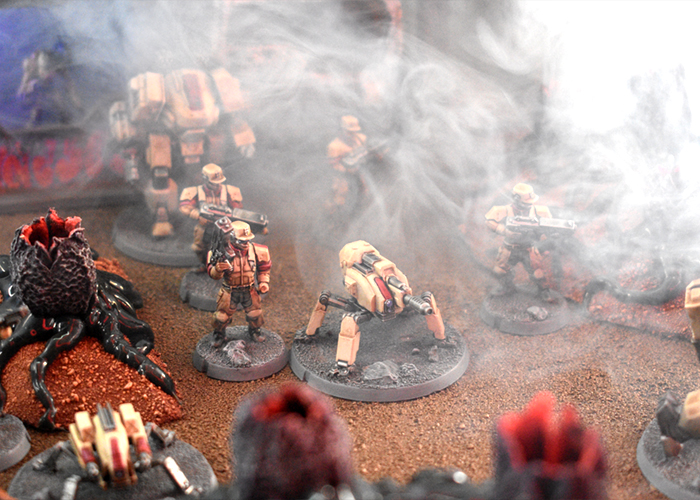
A Contractor Defender unit holds the line.
This digital model pack contains STL files for both supported and unsupported versions of the Contractor Drone, with multiple equipment options. The model has been slightly updated from the original resin release, with taller legs and the addition of the linked Strike Missile option. A 3D printed resin version will also be added to the webstore in the near future.
Contractor Drone Render
These drones are added to Contractor Defender or Contractor Scout units. You can find the rules for these units in the downloads section of the Maelstrom's Edge website here.
Start building your army of shooty robotic doom by grabbing your Contractor Drone from the webstore here!
New STL Release for the Broken - Forsaken Tech Chieftain
Posted on Monday Jul 10, 2023 at 05:00pm in Models
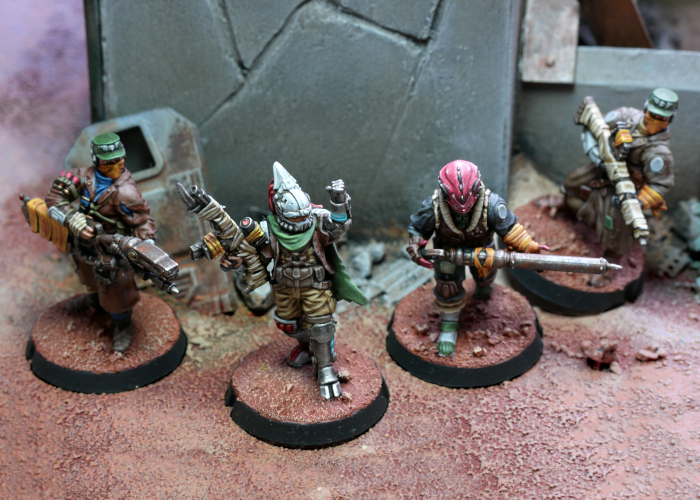
A Chieftain leading a Rabble unit into battle.
This digital pack includes both supported and unsupported files of a male and female version of the Tech Chieftain, and with options for two different customised weapons: a beam blastgun or a slug rifle.
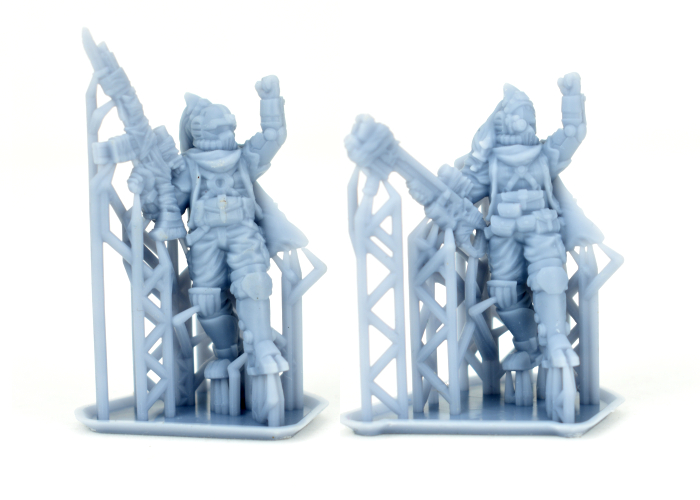
3D printed examples, printed on an Anycubic Mono 4K using Elegoo ABS-like resin at 35μm using Lychee slicer.
Printing results will vary depending on your printer, resin and settings.
You can find the rules for fielding these models in the downloads section of the Maelstrom's Edge website here.
Start building your strike force of cybernetic doom by grabbing some Broken models from the Maelstrom's Edge webstore here!
The Ancient Realms Siege Engine Kickstarter is now live!
Posted on Monday Jun 19, 2023 at 04:02pm in Ancient Realms
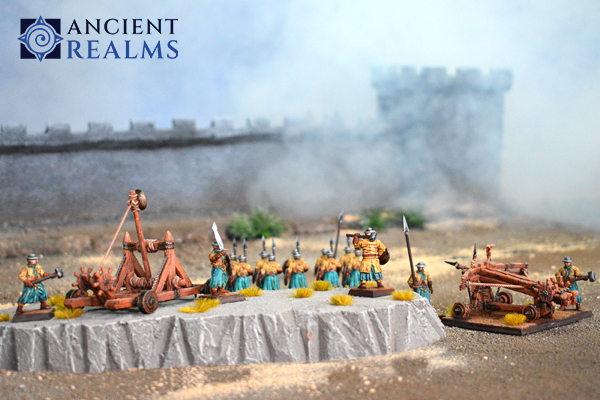
You can find it here!
New Kickstarter Campaign inbound - Siege Engines!
Posted on Friday Jun 16, 2023 at 05:00pm in Ancient Realms
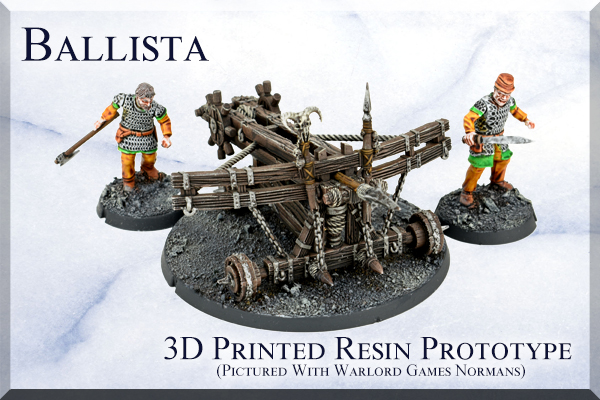
The campaign is launching with two kits available as rewards - the ballista and mangonel. These are supplied without crew or bases, so you can add your own to fit them into whichever game system you choose. Stretch goals will unlock a covered battering ram and trebuchet as add-ons.
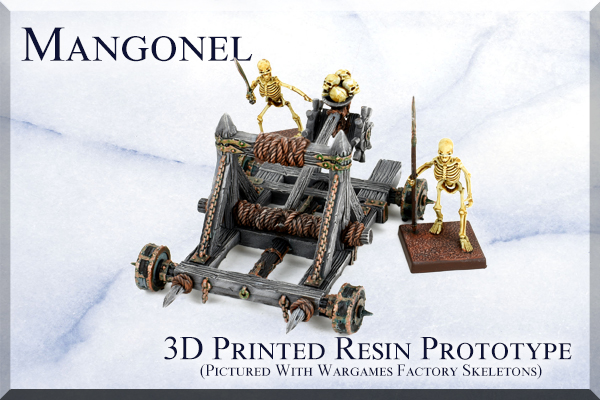
The campaign is due to launch on Monday the 19th of June, and will run for two weeks. Visit the pre-launch page here and click the 'Notify me on launch' button to receive an automatic reminder when the project goes live!
Tags: kickstarter
New STL Release - Broken Forsaken Chieftain
Posted on Monday May 29, 2023 at 05:00pm in Models
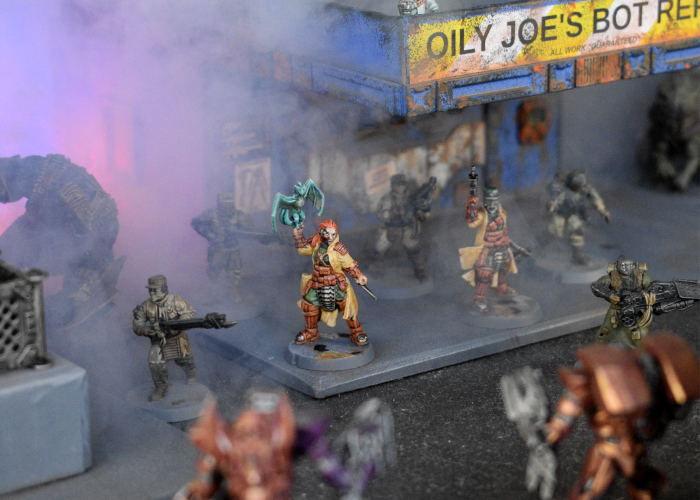
The appearance of a Chieftain varies wildly based upon the culture of their original planet and also the Freeport that they currently call home. They tend to have slightly nicer clothing and equipment than standard rabble, and many Chieftains see it as their duty to show that an individual can still rise up through the ranks of the Broken while carrying themselves with dignity and class. When a powerful enemy combatant is felled in battle, a Chieftain will confiscate something of value from them, whether it be a chunk of armor or an heirloom weapon. These purloined treasures are worn into future battles by the Chieftain, both as a reminder of the victory, and a symbol of their great leadership.
Originally released in resin, the Chieftain now available to purchase in STL form for 3D printing, from the Maelstrom's Edge store here!
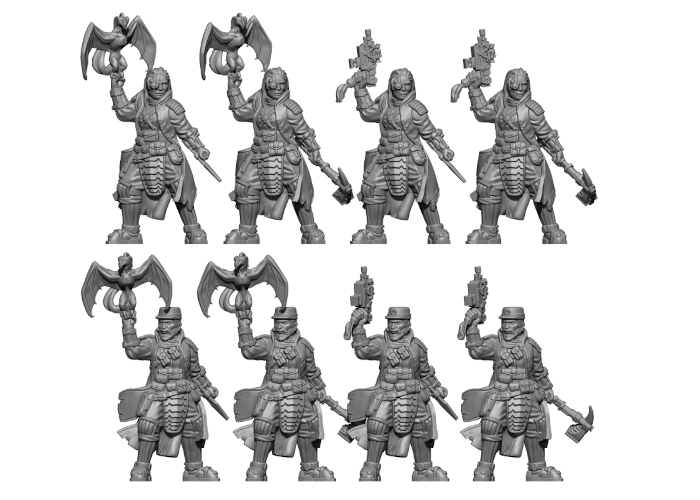
The included model variants.
This digital pack includes both supported and unsupported files of a male and female version of the Forsaken Chieftain, and with options for a poisoned blade or trophy melee weapon in the left hand and a slug pistol or xenos spotter for the right hand.
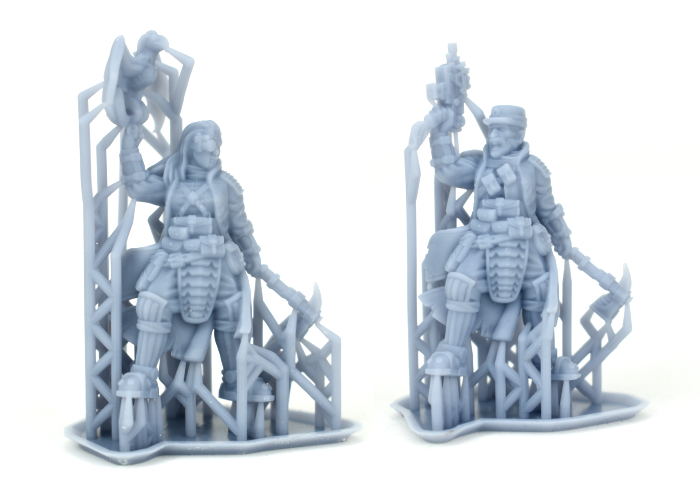
3D printed examples, printed on an Anycubic Mono 4K using Elegoo ABS-like resin at 35μm using Lychee slicer.
Printing results will vary depending on your printer, resin and settings.
You can find the rules for fielding these models in the downloads section of the Maelstrom's Edge website here.
Start building your strike force of sneaky doom by grabbing some Broken models from the Maelstrom's Edge webstore here!
Terrain Tutorial: Alien Plants from Seedpods and Hot Glue!
Posted on Saturday May 06, 2023 at 05:00pm in Tutorials
 - by Iain Wilson
- by Iain Wilson
Anyone who scratchbuilds terrain knows that the best part of the process is finding new things to turn into terrain! I recently wound up with a whole box full of black hot glue sticks, and had been looking for a good project to use some of them up. Then my wife came home with a bag of seed pods she had collected from a tree she saw somewhere, and an idea was born. Read on to see how these alien ... er... plants? Yes, that'll do... came to life!
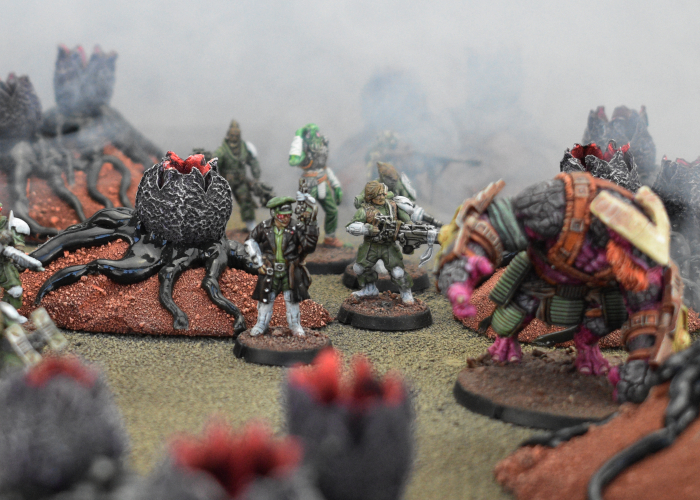
I started out with some blue insulation foam. If you haven't used this stuff before, it's a very firm expanded polystyrene sheet that some people use for insulating walls or somesuch boring thing, and sensible people use for making terrain as it's more solid and durable, and easy to work with than the more common white foam sheet.
Using a sharp knife, I cut the foam sheet into a low, hilly shape. You can use a hobby knife for this, although I used an old kitchen knife. (Don't use your good knives, as cutting foam will dull the blade!)
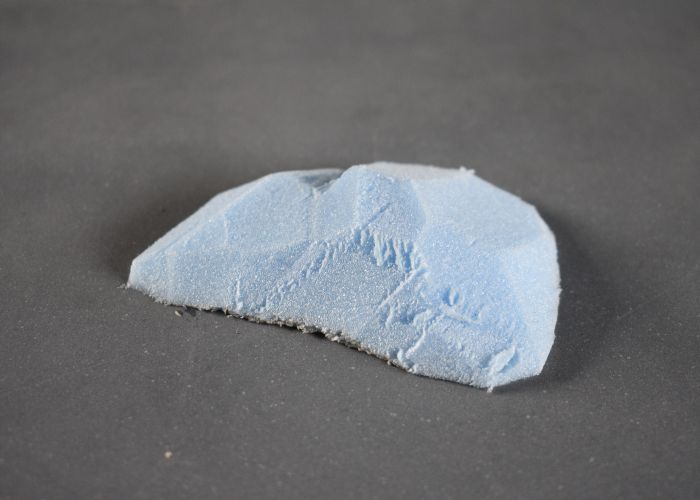
After painting a generous coat of PVA glue over the foam, I sprinkled on a couple of different types of sand, to create some varying texture over the whole thing.
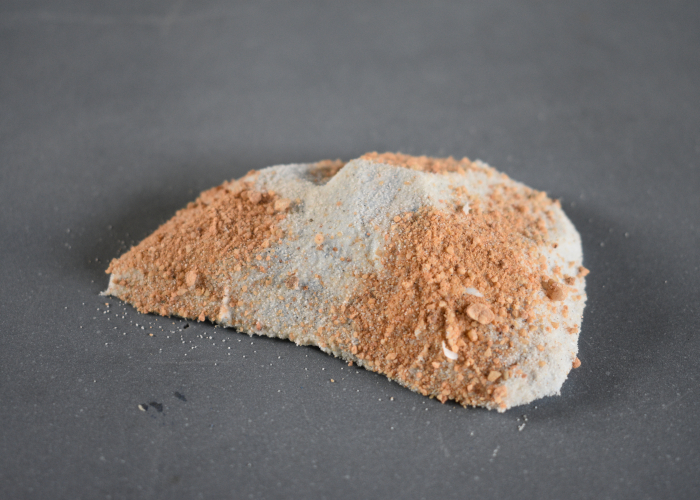
Once the PVA had time to dry, I used a blob of hot glue to stick a seedpod in place. (For multiple pieces, making the base pieces different sizes and using different numbers of seedpods on each will help avoid them all looking too similar on the table!)
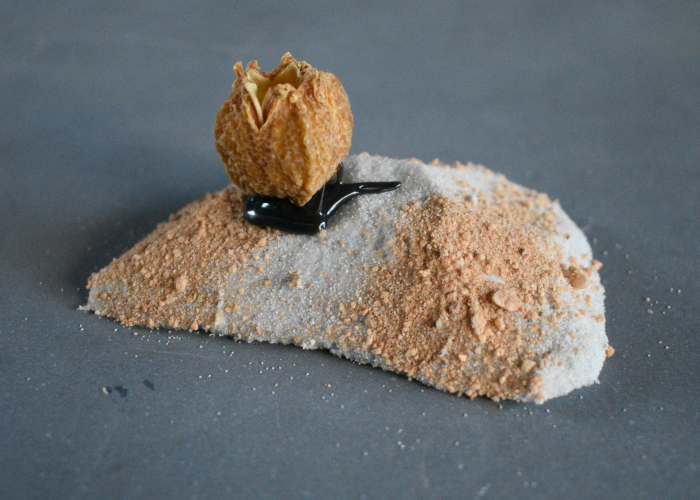
At this point, as I wasn't intending to paint over the hot glue parts of the plants, it was time to get some paint on, starting with a spray of matte white.
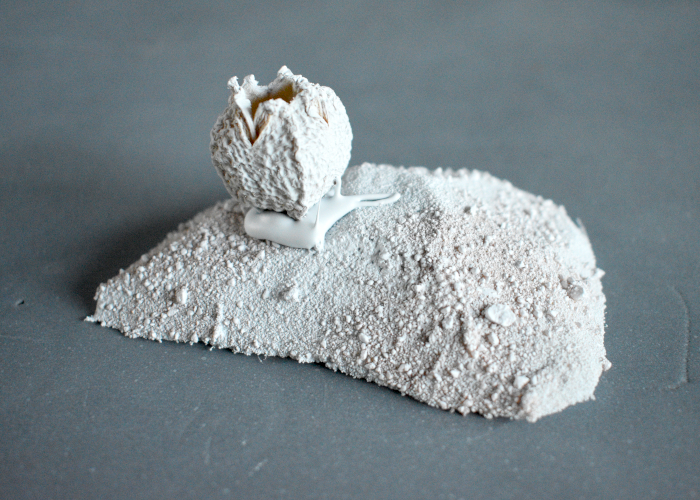
I then added some colour using Army Painter Speedpaints - Blood Red on the inside of the pod, Hive Dweller Purple on the outside, and a generous coat of Hardened Leather over the sand. A coat of matte sealer can also be a good idea here, to make sure that the seedpod is not exposed to the air so it will be preserved.
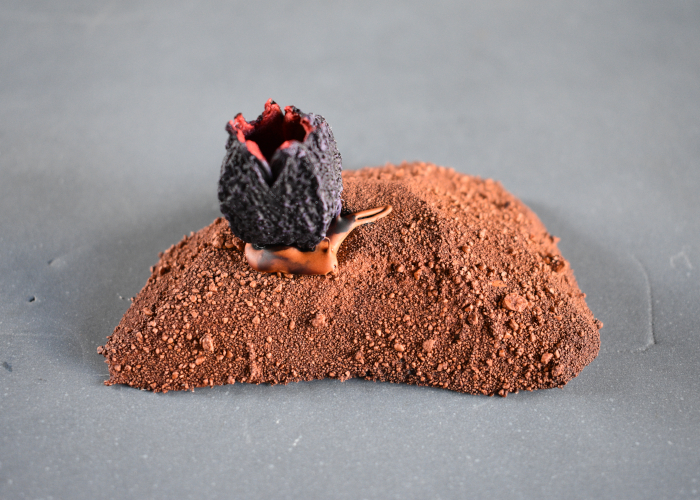
After giving the paint plenty of time to dry, it was time to go to town with the glue. Using a hot glue gun, I placed tentacle-like trails of glue outward from the seedpod, working around the pod to completely enclose the bottom of it.
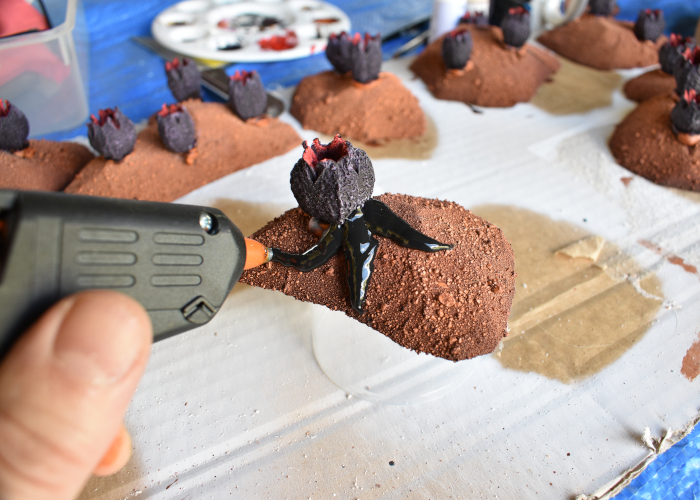
A couple of tips here:
- Allowing a minute for the previous tentacle to cool before doing the next one helps to avoid them sinking into each other. If you're working on a piece with multiple pods, then doing one at a time on each pod is a handy way to go.
- Depending on how good your glue gun is, it may build up more heat (making the glue runnier) the longer it is on. This can make it harder to keep good, defined tentacle shapes, so taking a break and turning the gun off for a while can help if you're having trouble making good shapes. Although just working faster can also help, as the glue stays firmer if it is not sitting in the gun for as lone - by varying the speed you push the glue through, you can make the tentacles gloopier looking or more defined, to suit your preference.
The tentacles all in place:
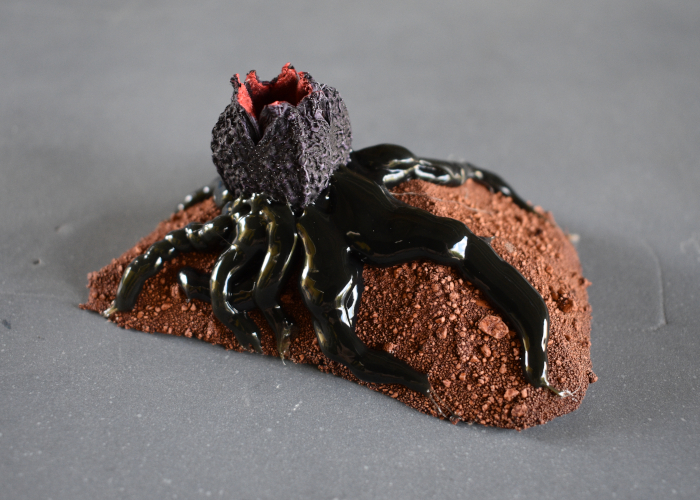
(A couple of these are a little gloopier than I wanted, due to me taking a bit longer to place them while I was trying to get pics of the process, but they'll look fine in the overall terrain patch!)
To finish up, I added a light drybrush of Game Color Bonewhite over the exposed sand areas, and a mix of the Bonewhite and White over the outside of the seedpod to pick up some of the texture.
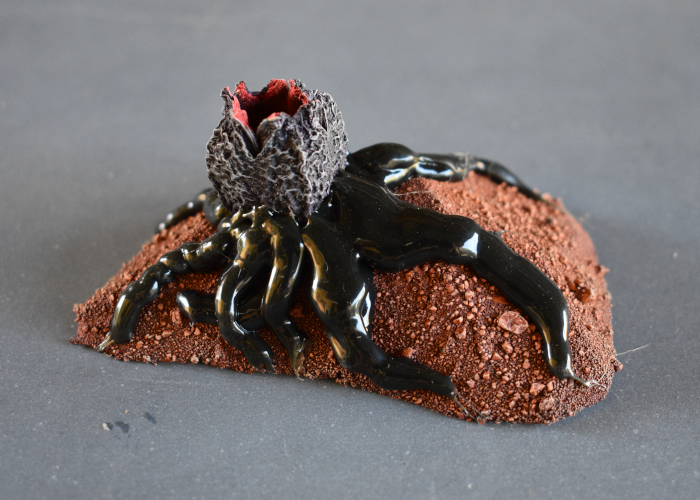
A gaggle of pod pieces all ready for the table:
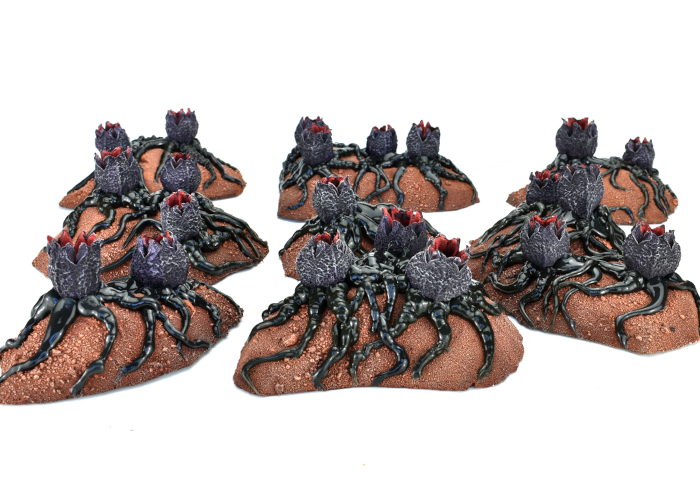
You could easily vary this to suit your own table by using different coloured glue sticks, and obviously you'll get very different results depending on the type of seedpods you use!
Once you have your vast plain of sinister biological doom, head on over to the Maelstrom's Edge webstore here, to pick up an army to run around in it!
What are you working on? We would love to see your models and terrain in the Comm Guild Facebook group!
For other building ideas, modeling tutorials, army spotlights and conversion walkthroughs, check out the Hobby section of the Maelstrom's Edge website here. And while you're there, grab a copy of the Maelstrom's Edge V2 Beta rules!
Epirian Foundation Colours - Maelstrom's Edge V2 Rulebook Preview
Posted on Wednesday Apr 19, 2023 at 06:00am in The Epirian Foundation
The Epirian Foundation‘s robotics and terraforming technologies transformed much of the Spiral Arm. The Foundation took barren, lifeless worlds and made them habitable, exploiting the resources of rocks they couldn’t turn into homes. The Foundation itself was formed as a loose coalition of independent franchises, each specialising in their own unique technologies. This guide shows just some of the many different franchise uniforms. You are of course free to come up with your own colour schemes, whether for a home-made franchise of your own, or as an alternate uniform for an existing franchise - while militia units within a franchise generally all use the same equipment, variations can occur on worlds where specific supply or environmental considerations force them to rely on local alternatives.
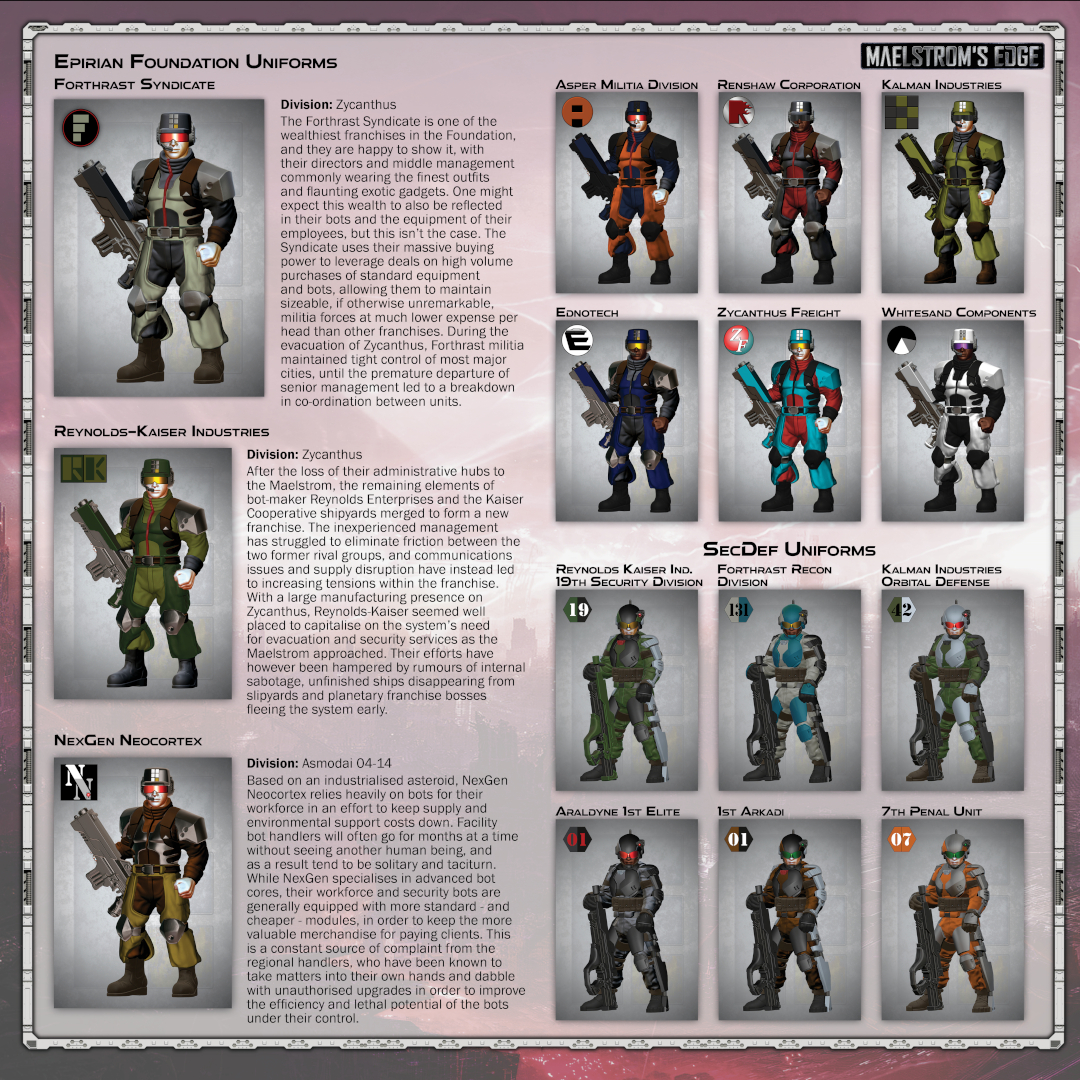
(Click the image for a larger version!)
To get started on your own army of corporate doom, pick up the Epirian models, or any of the rest of the range from the webstore here.
What are you working on? We would love to see your models and terrain in the Comm Guild Facebook group!
Remember to also grab a copy of the Maelstrom's Edge V2 Beta rules so you can get into the action!
Modeling Spotlight: 'Lightyear' Hyperspeed Truck Repaint!
Posted on Thursday Mar 16, 2023 at 05:00pm in Models
 - by Iain Wilson
- by Iain Wilson
The 'Lightyear' movie from Pixar was accompanied by a 'Hyperspeed' range of rather cool vehicle and ship toys. While the 1" figures are too small to be useful, some of the vehicles actually wind up looking just about perfect alongside gaming miniatures. The truck, in particular, was just too good to not put on the table. So after grabbing some on special from a local department store, I pulled one apart and painted it up, to see how it would look!
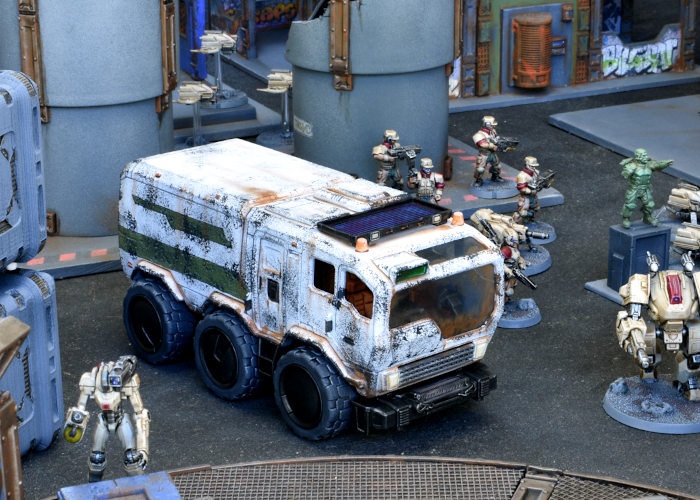
The truck is reasonably well detailed, and so to get the best results I decided to take it apart rather than trying to paint the fully assembled model. This turned out to be more difficult than expected, as two of the screws holding the back of the truck together are hidden behind the rear wheels, and the axles have textured ends that don't just pull out of the wheels - I wound up having to cut them and make a new rear axle. If I do any more of these, I'll probably just go the easy route and paint them assembled.
The truck in question before any modification:
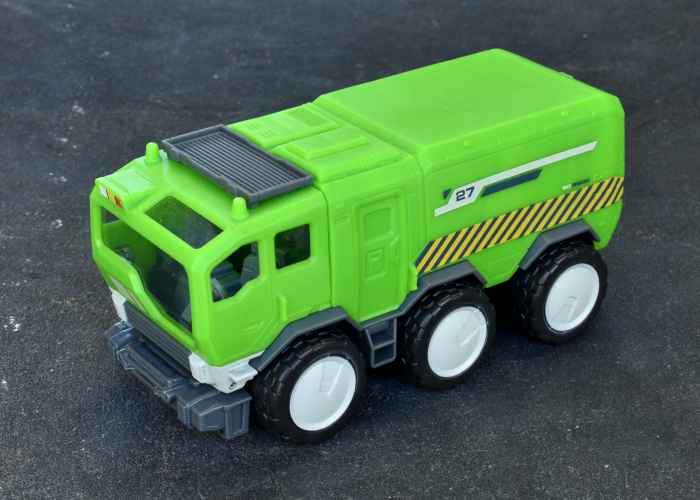
I sprayed the chassis and wheels with Army Painter Matte Black, and the rest of the truck with Uniform Grey and then a zenithal spray of Matte White, so the grey stayed in the creases.
I didn't sand the vehicle before painting, as I was feeling lazy. The paint stuck fine to the plastic, although the printing on the sides of the truck back is slightly raised, which left a noticable shape under the paint. So I decided to just use that existing shape as a template for my own coloured decoration.
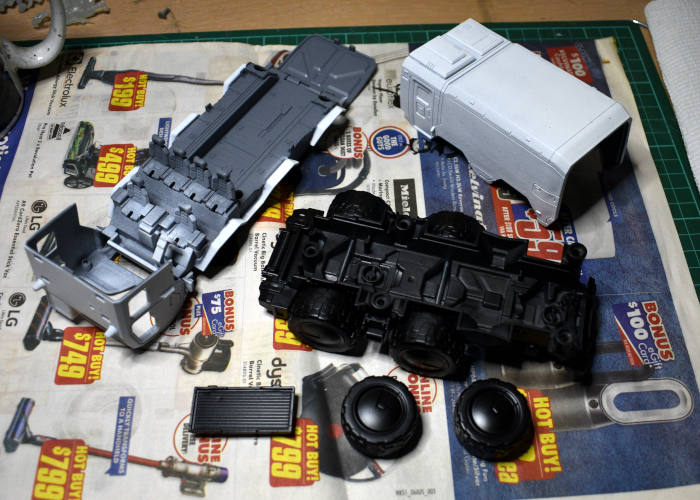
I kept the painting fairly simple, painting the seats with Army Painter Hardened Leather Speedpaint, and drybrushing the chassis with Citadel Boltgun Metal. The tyres were painted with Army Painter Uniform Grey, and then the chassis and wheels given a coat of Speedpaint Gravelord Grey. I wanted the truck to look a bit used, so after reassembling everything I weathered the white with some Vallejo Heavy Charcoal applied with a sponge, and drybrushed on some Vallejo Beasty Brown in the crevasses. The various lights were picked out with white and then various appropriate Speedpaints.
The finished truck, with the original for comparison:
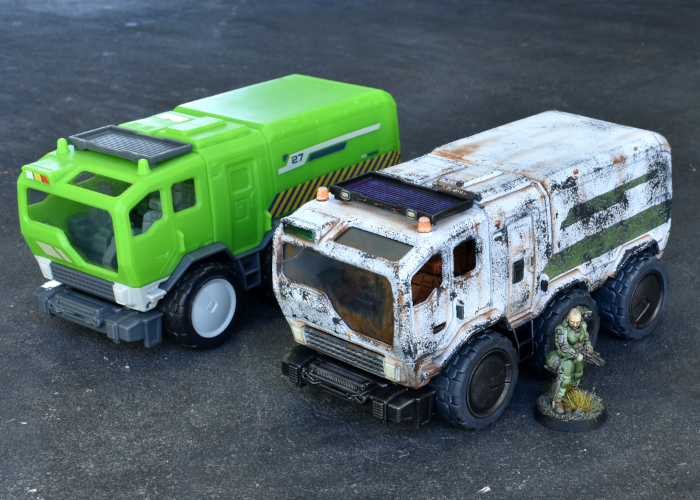
I'm calling it the 'ParSec 12 Medium Transport'. You'll get there in a ParSec!
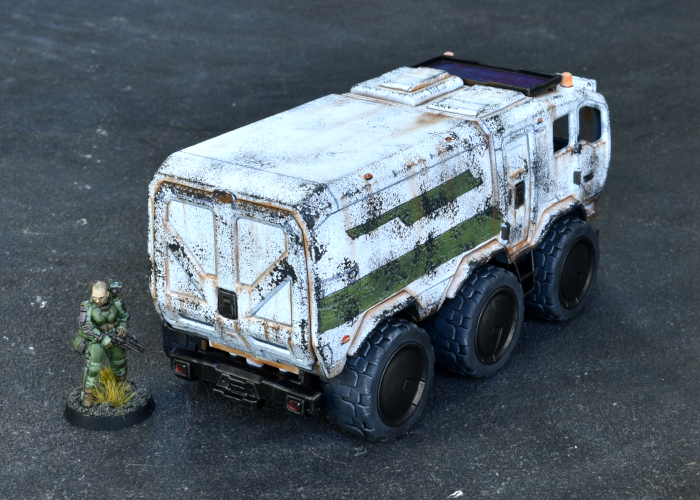
Once you've built your own fleet of cargo-carrying doom, head to the Maelstrom's Edge webstore here, to pick up some miniatures to attack it with!
We would love to see your models and terrain in the Comm Guild Facebook group. Pop in over there and share what you're working on!
For other building ideas, modeling tutorials, army spotlights and conversion walkthroughs, check out the Hobby section of the Maelstrom's Edge website here. And while you're there, grab a copy of the Maelstrom's Edge V2 Beta rules!
Karist Enclave Colours - Maelstrom's Edge V2 Rulebook Preview
Posted on Friday Feb 24, 2023 at 01:20am in The Karist Enclave
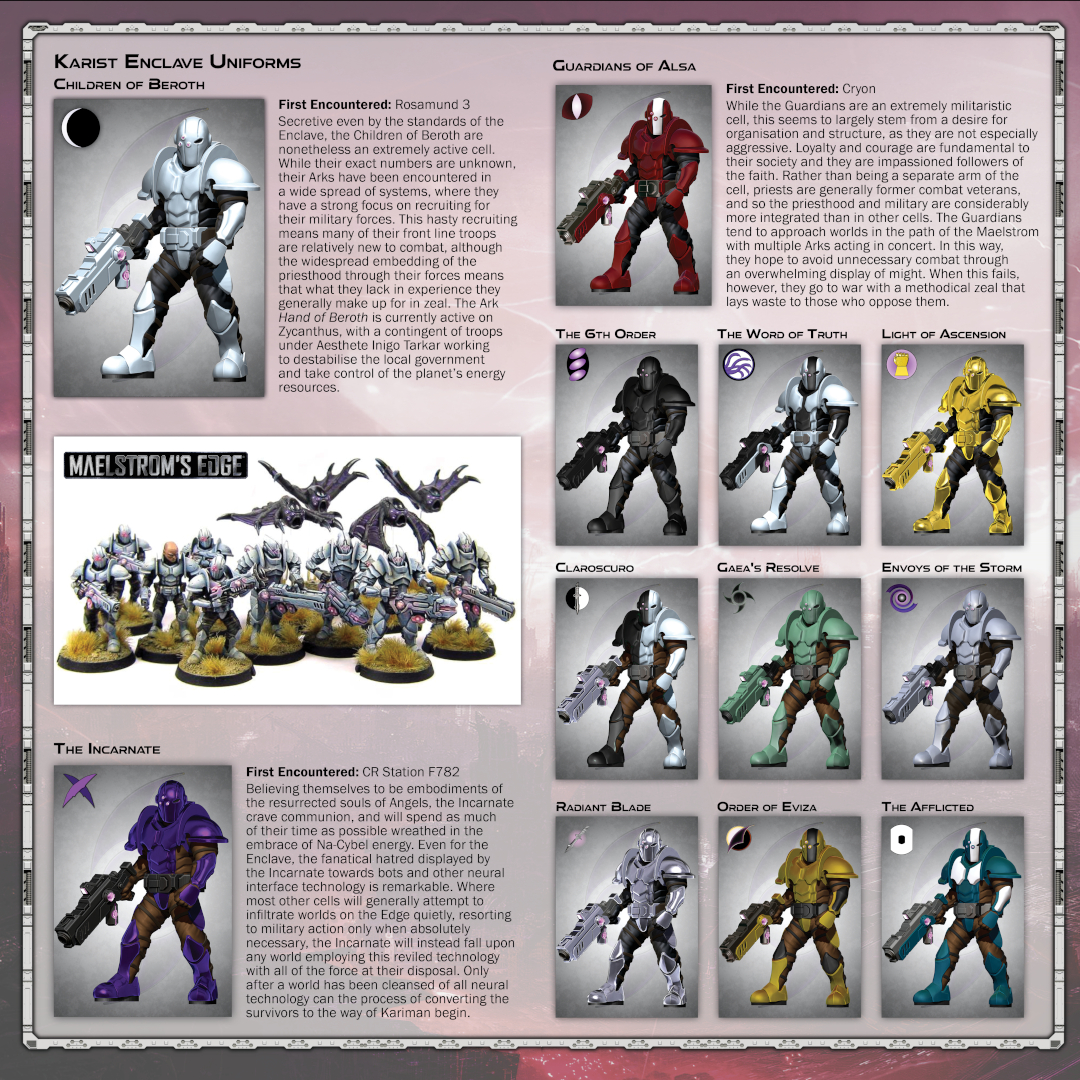
(Click the image for a larger version!)
To get started on your own army of over-zealous doom, pick up the Karist models, or any of the rest of the range from the webstore here.
What are you working on? We would love to see your models and terrain in the Comm Guild Facebook group!
Remember to also grab a copy of the Maelstrom's Edge V2 Beta rules so you can get into the action!
Army Spotlight: Marten's 90 point Karists
Posted on Tuesday Feb 14, 2023 at 05:00pm in The Karist Enclave
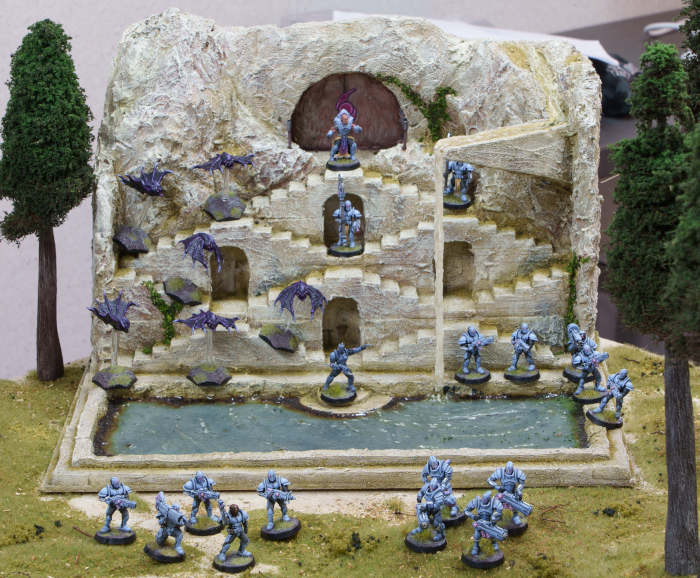
About his force, Marten says: "This is my 90pt Karist force. It's fairly small, which I find convenient for trying out new rules at first. I'm a fan of 'regular guys' in my forces. Hence there is no mature Angel, but two full sized squads of troopers, four Tempest Elites carrying the force's big guns and two Praetorians because they're cool. A Shadow Walker and a full complement of Minnows make up the fast element of the force, led by a Kaddar Nova.
The colour scheme was inspired by the painted examples on the Maelstrom's Edge kickstarter of 2015, combined with then new-to-me Warcolours paints which had a nice 5 tone 'blue grey' set.
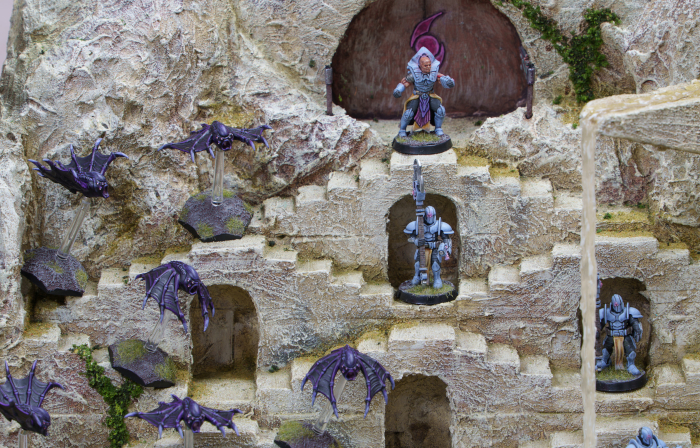
The Kaddar Nova overlooks his force, accompanied by his Praetorian escort.
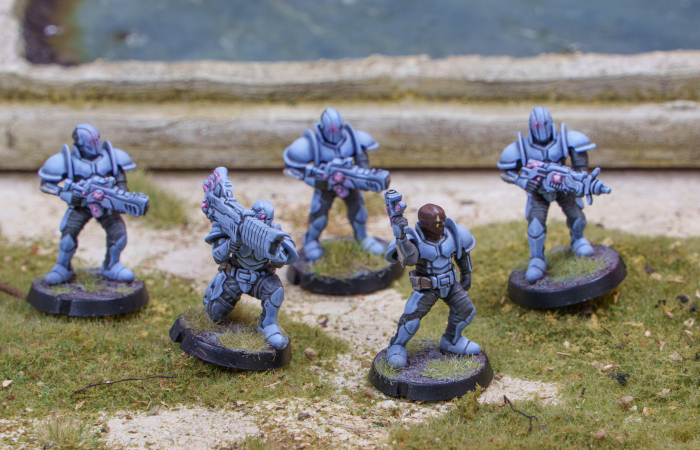
Karist Troopers, including a Heavy Trooper equipped with a devastating Cybel Lance.
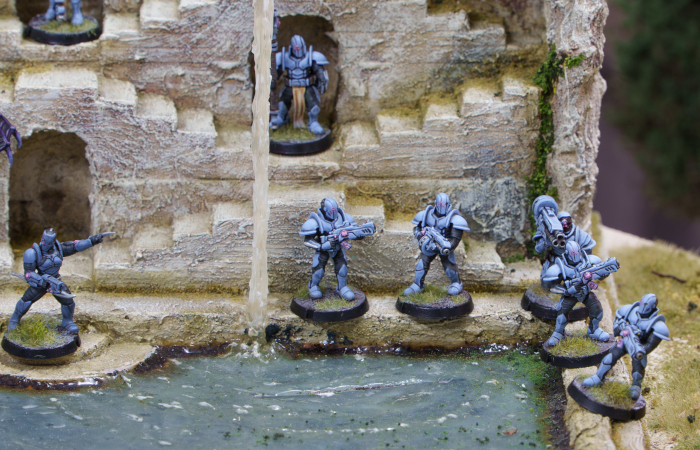
The second unit of Troopers, with a Ripper Heavy Grenade Launcher, and the deadly, teleporting Shadow Walker.
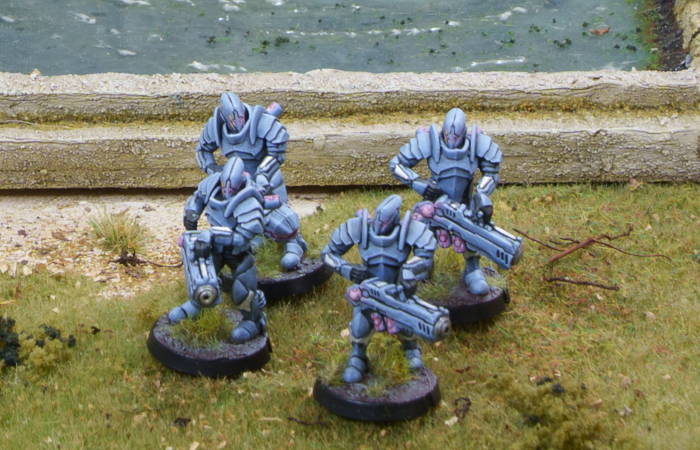
Tempest Elites are implacable fire support for Karist forces.
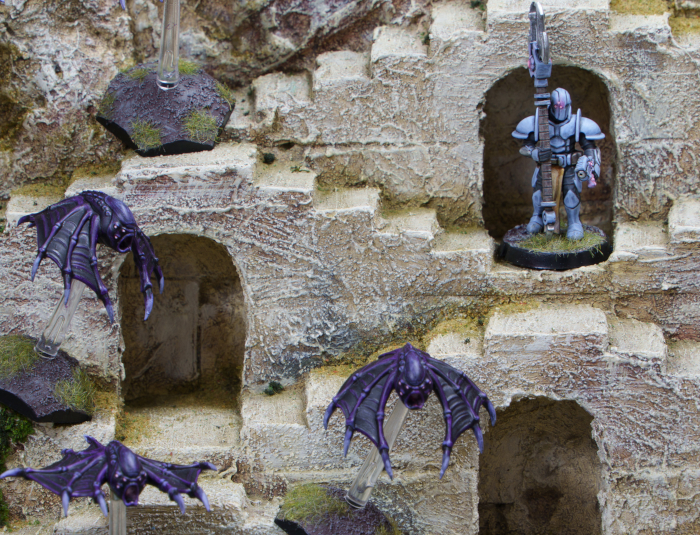
Though comparatively small, Minnows are no less ferocious than older Angels.
To get started on your own army of over-zealous doom, pick up the Karist models, or any of the rest of the range from the webstore here.
What are you working on? We would love to see your models and terrain in the Comm Guild Facebook group!
Remember to also grab a copy of the Maelstrom's Edge V2 Beta rules so you can get into the action!
StackaRack Pledge Manager is live!
Posted on Friday Feb 03, 2023 at 05:00pm in StackaRack
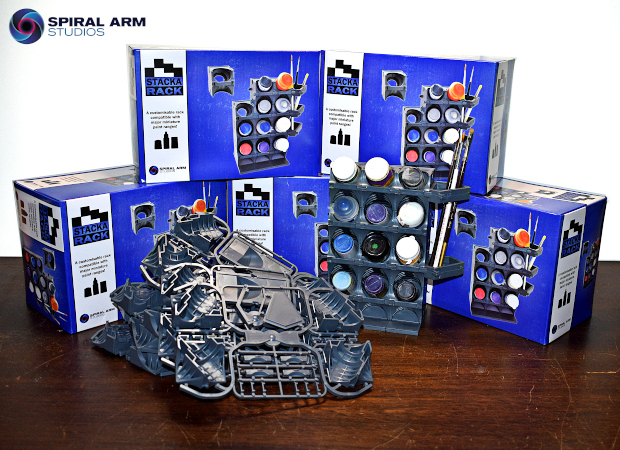
With covid-related delays and other complications along the way, it's taken a little longer than originally expected to get the final product in hand. At long last, though, StackaRack is in our warehouse and shipping out to Kickstarter backers.
The Pledge Manager on Gamefound is open now to both original backers and late pledges. Late pledges are (unavoidably) higher than the Kickstarter pledge levels, due to so many of the costs involved in StackaRack production increasing over the duration of the project, but are still a saving on the expected retail price of £24.99 a box.

Get in on the Pledge Manager here: https://gamefound.com/projects/spiralarmstudios/stackarack.
Tags: kickstarter stackarack
Army Spotlight: Marten's 90 point Epirians
Posted on Wednesday Dec 14, 2022 at 05:00pm in Models
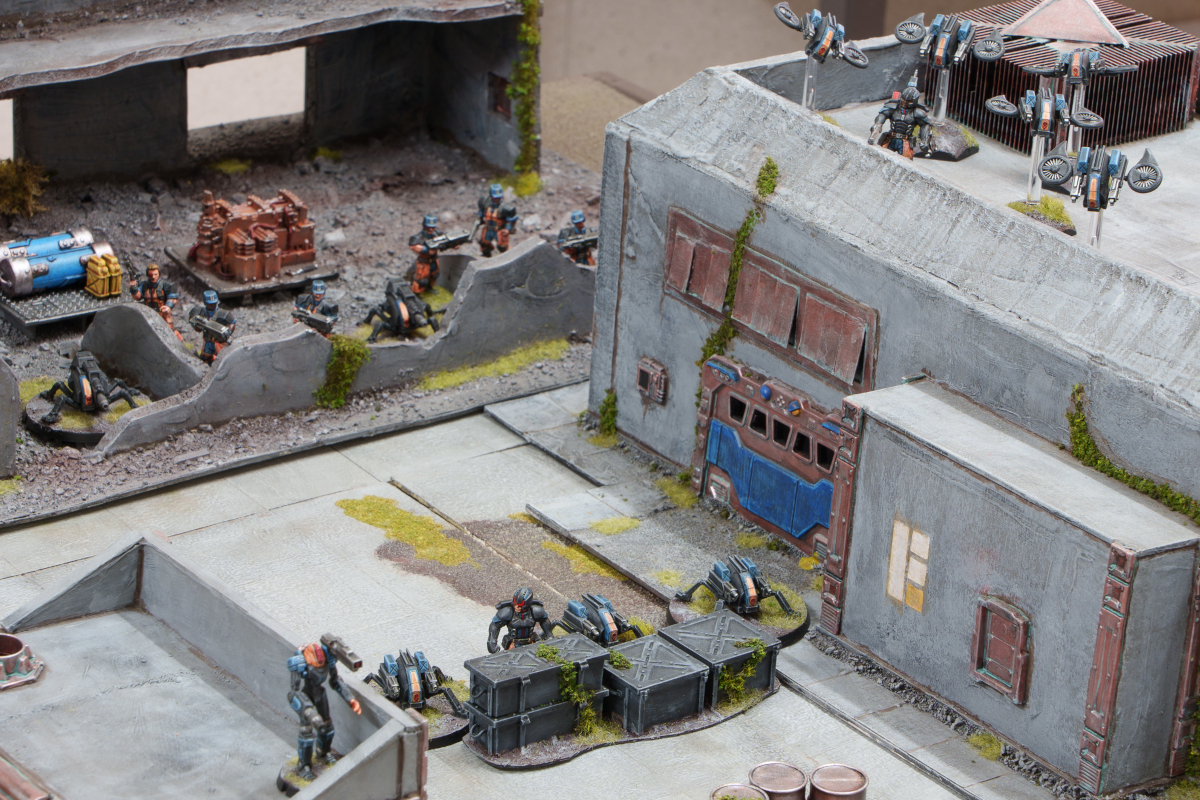
Built to fit on the table in 90 points for the V1 rules, Marten's force leans heavily into the various bot options. Contractors are all well and good, but accompanying them with chaingun-equipped support bots is even better!
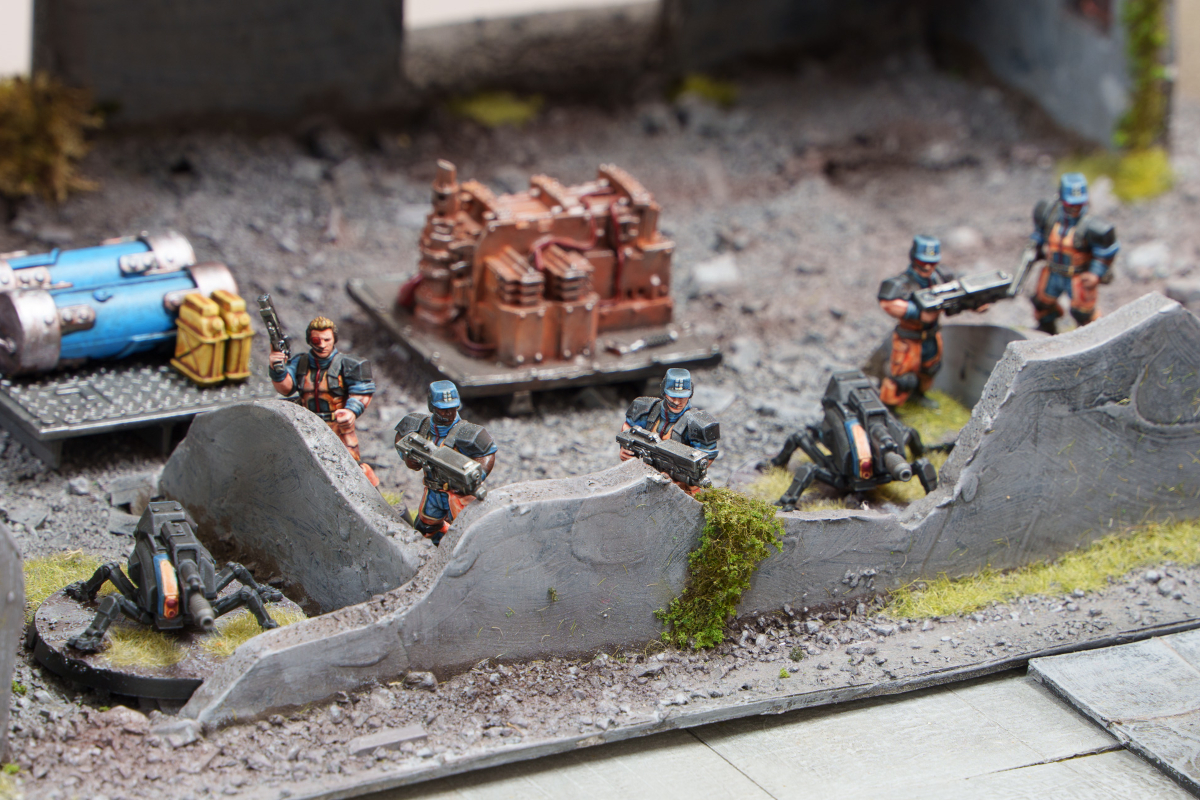
Contractors wisely ensconced in cover.
Fireflies are comparatively fragile compared to most other Epirian bots, but are superb when you need to get some firepower across the battlefield in a hurry.
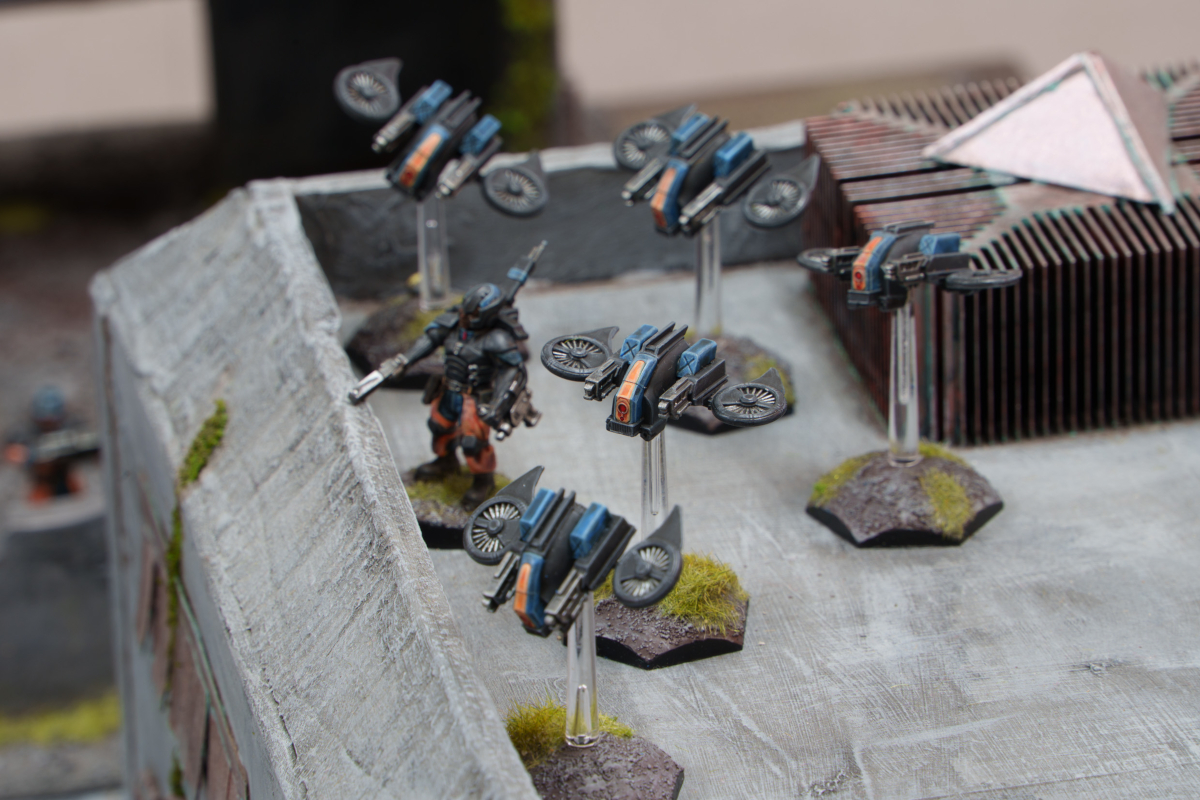
A Journeyman Bot Handler directs his Firefly cohort onto the battlefield.
Spider Drones are handy for decimating enemy troops, coming equipped with twin machine guns or flakk guns, and also excel at digging into cover to avoid enemy fire.
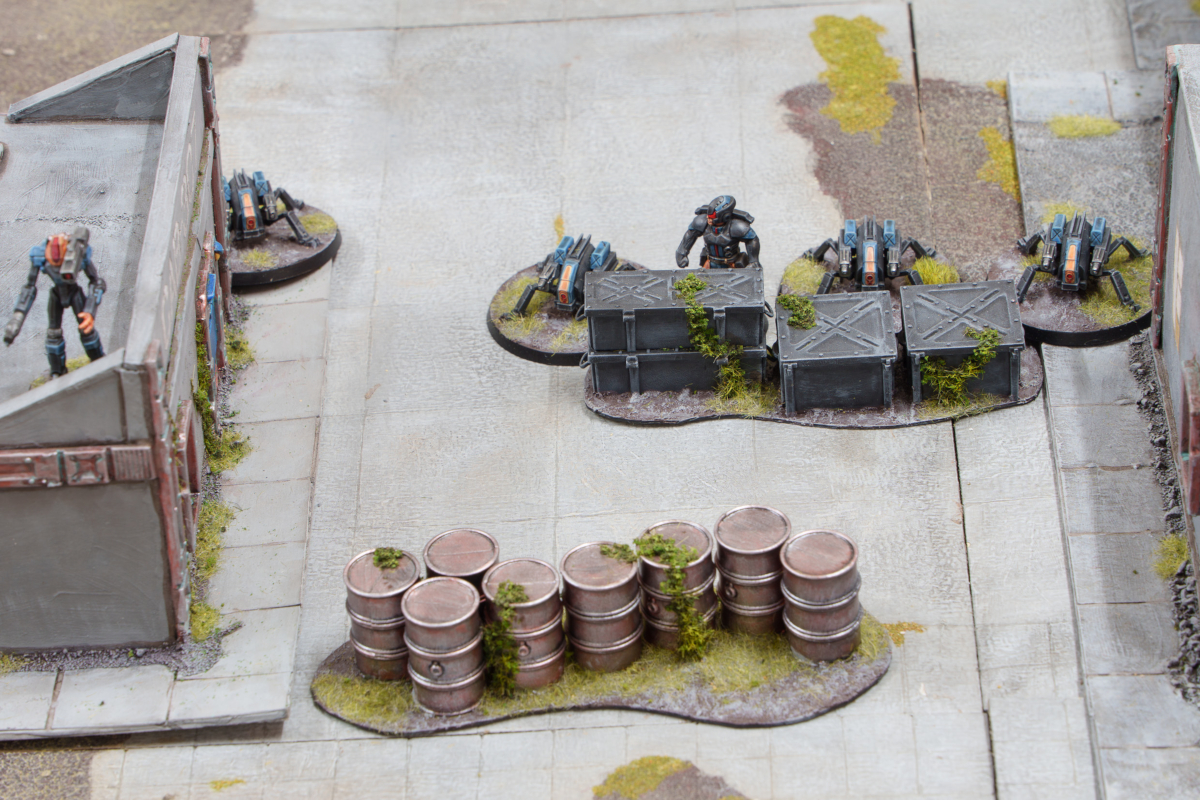
A unit of Spider Drones with their Apprentice Handler move up the centre under the watchful targeting lens of a Scarecrow bot.
A Scarecrow Sniper is a much more fearsome presence than its gangly frame might imply, capable of pummeling the toughest enemies at range with its shoulder mounted Maglock Railgun, or repelling closer foes with clingfire or chemical spray.
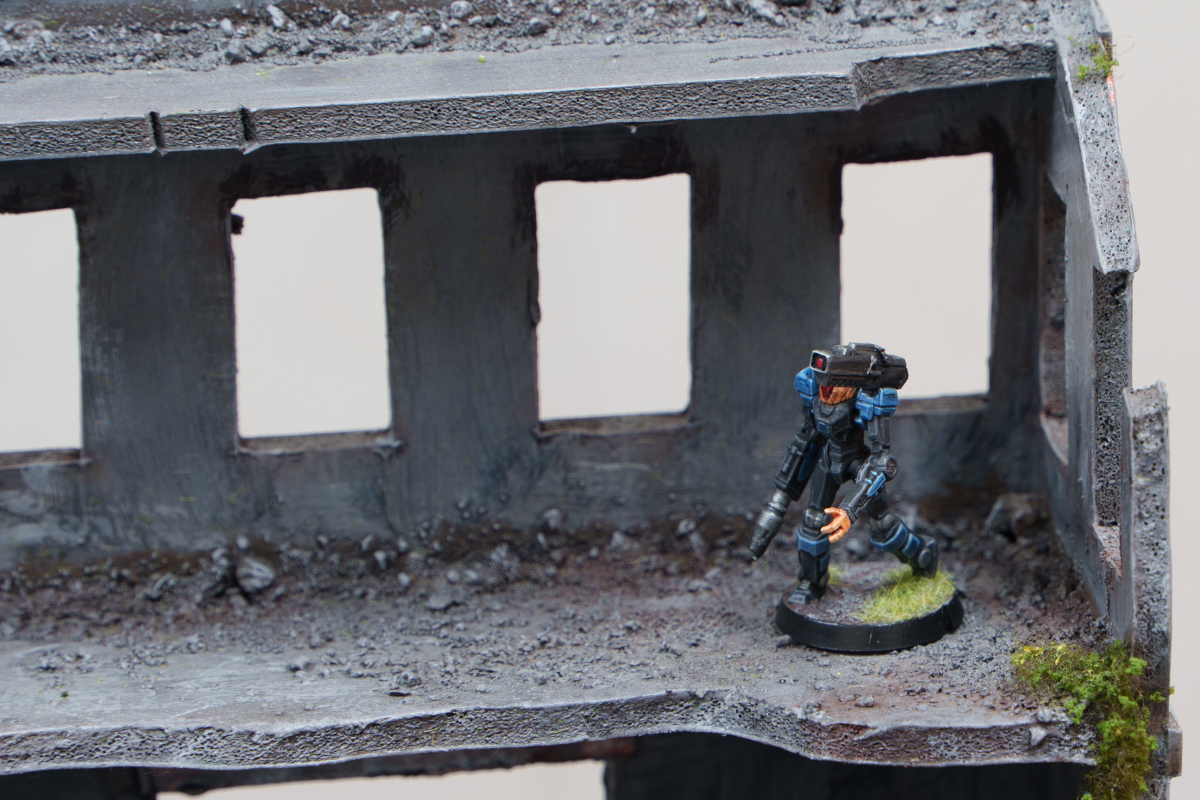
A second Scarecrow Sniper stands overwatch at the rear of the deployment.
To get started on your own army of robotic doom you can pick up these models, or any of the rest of the Epirian range from the webstore here.
What are you working on? We would love to see your models and terrain in the Comm Guild Facebook group!
Remember to also grab a copy of the Maelstrom's Edge V2 Beta rules so you can get into the action!
New Release: Epirian SecDef Character Model STLs!
Posted on Thursday Dec 01, 2022 at 05:00pm in Models
SecDef Medics are combat veterans who have received additional training and equipment to administer first aid in the field. Known for being level-headed under fire, medics accompany SecDef tactical teams in the field, where they need to be equally competent at using their carbines or treating wounded squadmates.
Originally released in resin, these two SecDef character models are now available to purchase as STL files for 3D printing, from the Maelstrom's Edge store here!
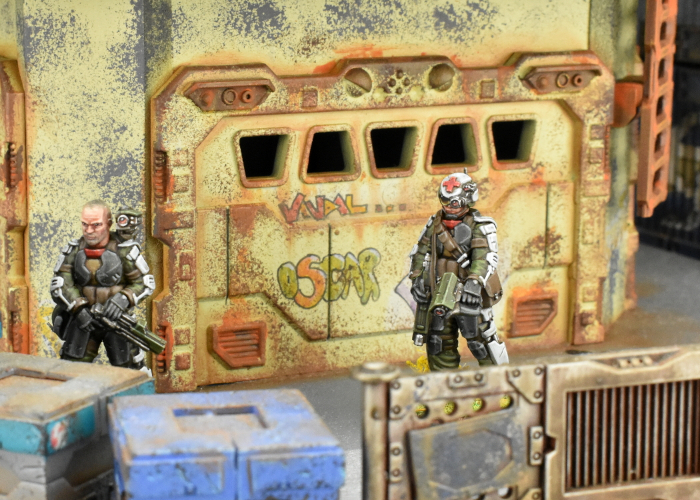
This digital pack includes both supported and unsupported files, and two different weapon options for the Lieutenant.
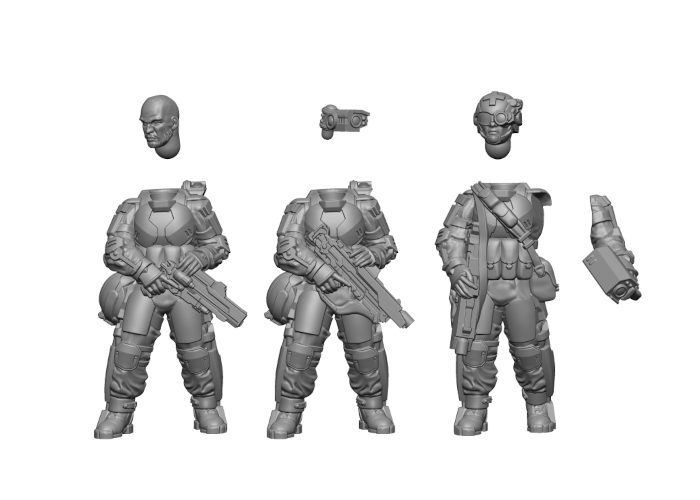
The included parts.
You can find the rules for fielding these models in the downloads section of the Maelstrom's Edge website here.
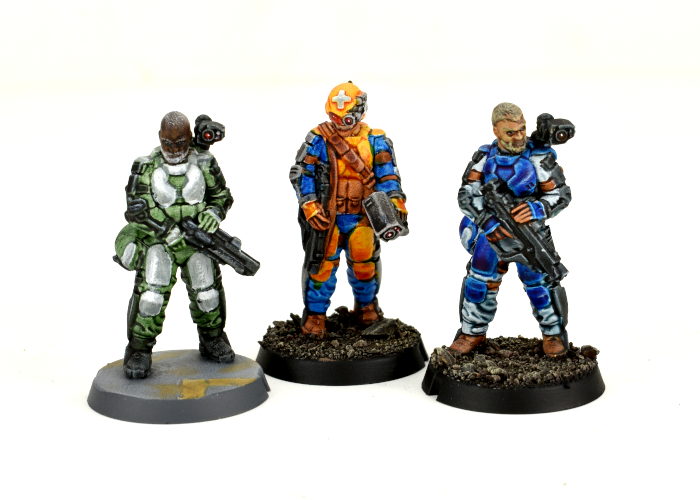
3D printed examples, painted to a tabletop-ready standard - printed on an Anycubic Photon using Siraya Tech Fast resin at 50μm using Lychee slicer.
Printing results will vary depending on your printer, resin and settings.
Start building your elite force of corporate doom by grabbing some SecDef models from the Maelstrom's Edge webstore here!
Tags: epirian lieutenant medic secdef stl
Painting Tutorial: Quick & Easy Rust!
Posted on Wednesday Nov 23, 2022 at 05:00pm in Tutorials
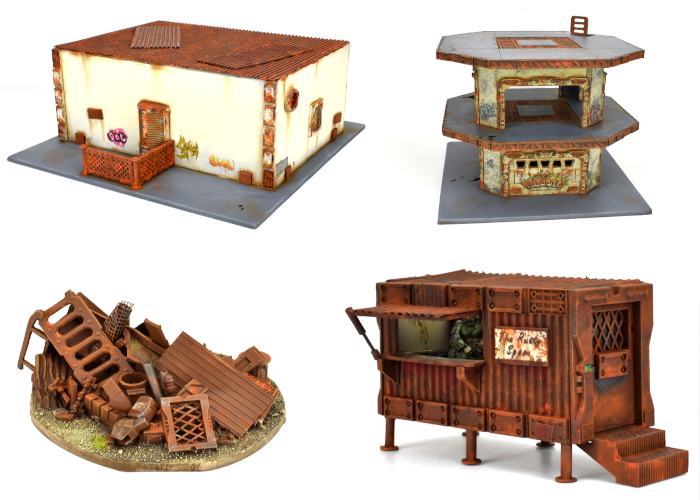
I'm using a fan assembly from the Maelstrom's Edge terrain sprues here (the fan from Sprue #2, and the large pipe fitting from Sprue #1).
Start with an undercoat of a mid to dark brown.
Note: The actual colour isn't too important - and that goes for the rest of this tutorial as well - as rust comes in a wide range of shades and textures depending on the surface and the level of corrosion. I have shown the specific colours I used for this tutorial in the images, but you should feel free to experiment with different shades to get an effect that you like!
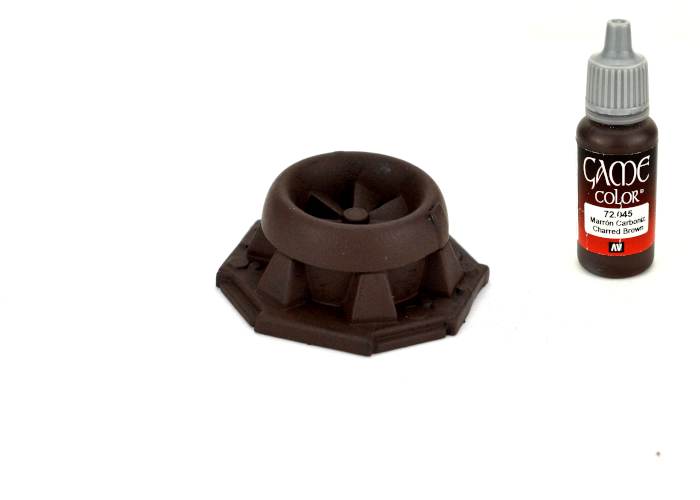
Using a sponge, dab on some patches of mid to dark grey. This is an optional step, to keep some areas where the original metal is still showing through. If you are looking for a more solid level of corrosion, skip this step.
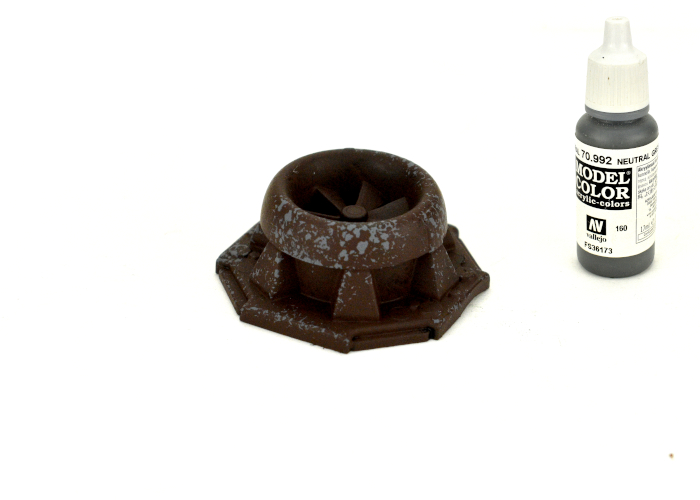
Drybrush with orange. As above, use whatever actual shade you choose, the goal is just to add some contrast on the brown. You can build up some different patches of corrossion if you want by using a couple of different oranges or reds here, but avoid using anything too bright.
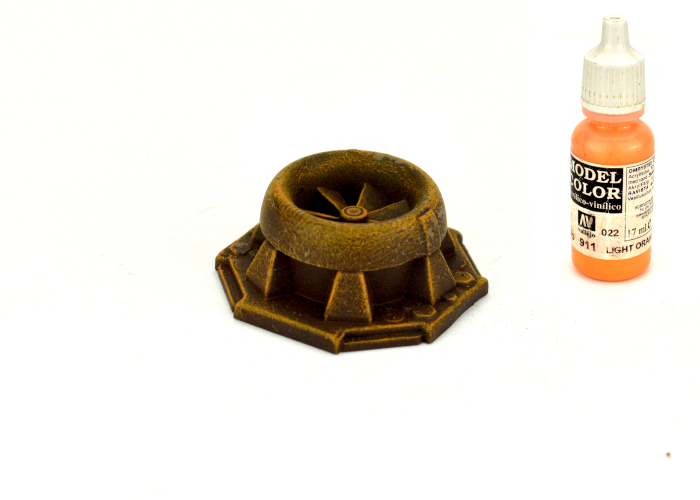
Finally, use an old brush to dab on some rust effect paint. I use Army Painter Dry Rust, but there are variations on this same style of paint in quite a few different paint ranges. This is a very matte orange paint that is also quite thin, so once you dab it around it dries with a lighter tint over the areas where less of it is applied, while building up a more solid rust look where the paint is heavier. Don't try to smooth it out - just blob it on there. If you're bothered by the technical aspect of metal weathering, try to apply the rust paint more heavily on those areas where it would naturally be more exposed and so corrode more - Looking at pictures of rusted metal objects can help here - otherwise, just dab it on there wherever it looks right to you. Gaming models don't have to be strictly real-world accurate unless you want them to be!
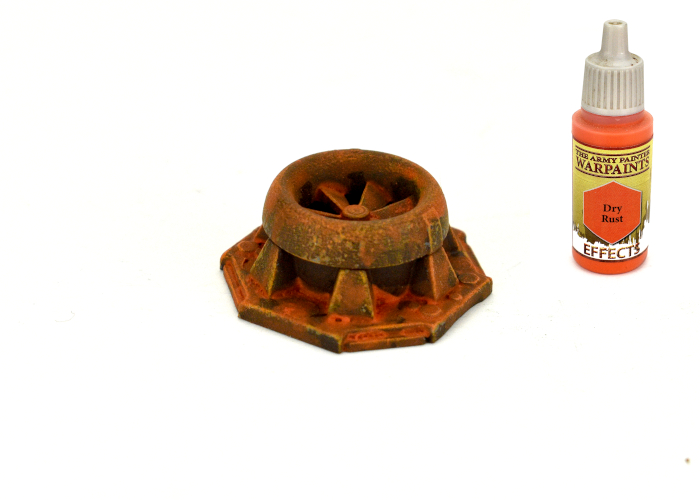
And that's it. Once the rust paint has dried, it's good to go. You can use this technique wherever you want some rusted surfaces, varying the colours and application to suit whatever you are painting at the time!
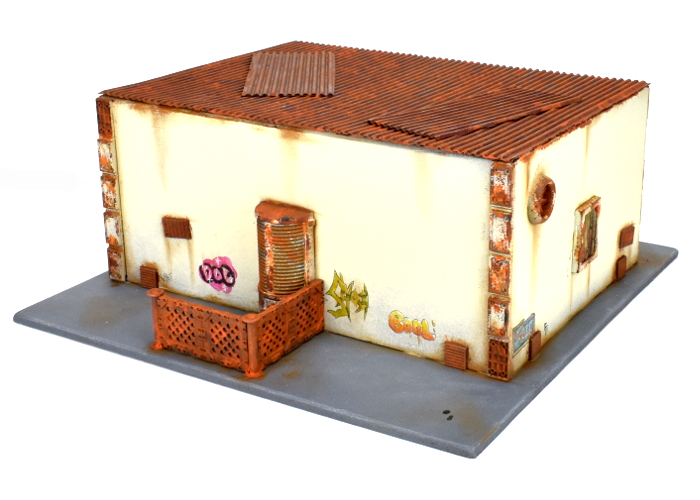
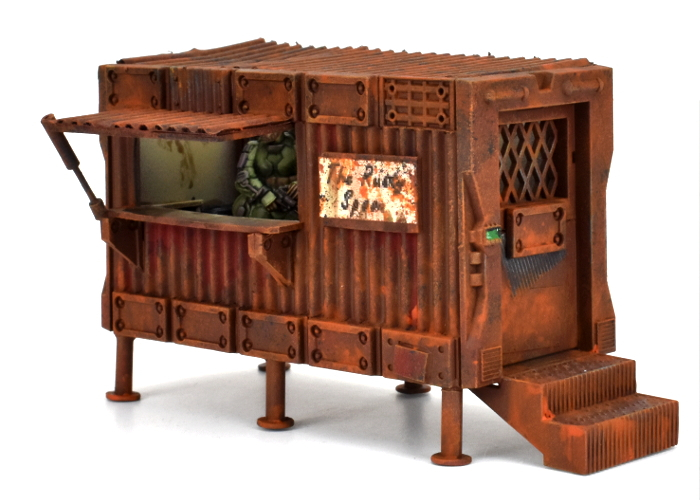
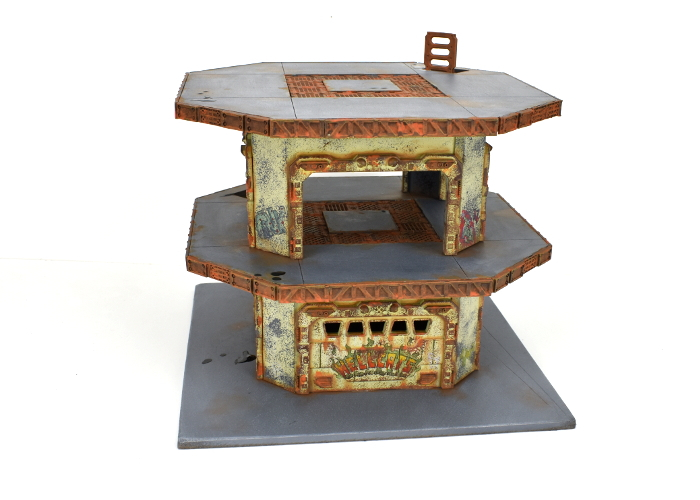
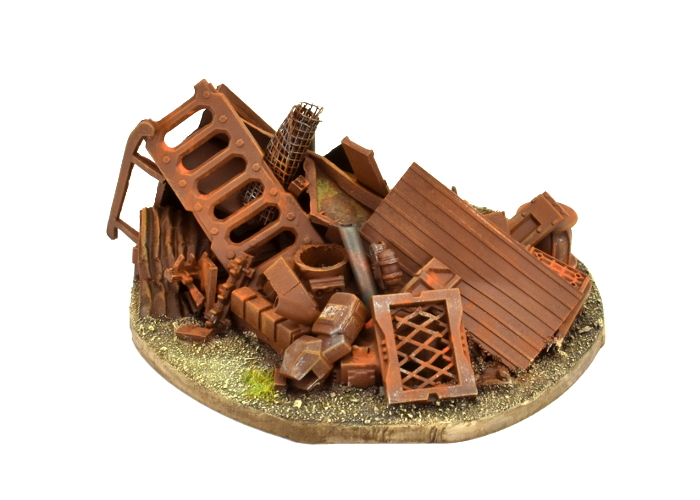
To get started on your own city of corroded doom, pick up the Maelstrom's Edge terrain sprues along with the rest of the range from the webstore here.
What are you working on? We would love to see your models and terrain in the Comm Guild Facebook group!
Remember to also grab a copy of the Maelstrom's Edge V2 Beta rules so you can get into the action!
Tags: painting rust tutorial walkthrough
